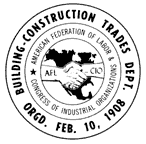Gary Mirka, Dan Kelaher, Todd Nay and Tim Lutz
Contact Information:
Dr. Gary A. Mirka
Dept Ind Eng Box 7906
North Carolina State University
Raleigh, NC 27695
Phone: (919) 515-6399
Fax: (919) 515-5281
http://www.ise.ncsu.edu/mirka/
http://www.ise.ncsu.edu/ergolab/
BACKGROUND
Workers
in the home building industry are exposed to most of the recognized occupational
risk factors for back disorders including heavy work, materials handling,
pushing, twisting, frequent lifting over 25 pounds, requirements for sudden
unexpected maximal effort, awkward
postures. Engineering controls for the reduction of low back injuries
in this population was the focus of this study.
METHODS
The biomechanical demands placed on low back of workers from three
trades within the home building industry (masons, drywall hangers and
framers) were quantified using the CABS method (Mirka et al, 1998a, 1998b)
From this data, the activities that placed the workers at risk of low
back injury were identified and 15 different interventions were developed
and evaluated in the lab and field. Described below are a small subset
of these tasks along with a description of the interventions developed
and their lab and field assessments.
WALL CYLINDER
When framers complete the construction of a wall, typically it is
lying on the floor. The workers then get together and manually lift the
wall the vertical position. This exposes the workers to high loads on
the spine while in extreme flexed postures. A wall lifting device was
created that utilizes an air cylinder capable of producing a lifting force
of 1200 lbs. An attachment harness is secured to the header of the wall
and then the cylinder lifts the wall to slightly above head height. At
this point the framers can easily push the wall the rest of the way to
the vertical position. Laboratory analysis of this device documented tremendous
reduction in loads on the spine and field assessment indicates great enthusiasm
for the design, particularly for the increased
productivity in developing wall for the second story where application
of sheeting after the walls were erected was an annoyance with the existing
methods.
DRYWALL LIFT
The installation of drywall often requires excessive spine extension
and high loads. We identified a commercially available product called
PANEL LIFT that is able to lift the sheetrock into place in both
the horizontal and vertical orientations and then the worker can use a
screwgun with an extension to secure the panel. Laboratory and field evaluations
of the intervention showed decreased low back stress while using the device,
but construction workers expressed concerns related to productivity.
NAIL GUN ATTACHMENT
When framers are securing the sub-flooring material to the floor
joists or floor trusses they most often use a nail gun. This requires
that they spend a great deal of time with their trunk in a fully
flexed posture, often for hours at a time. The static loading of the ligaments
and muscle of the back along with the extreme posture of the lumbar spine
make this a job with potential risk for cumulative trauma. A handle was
designed and fabricated that allows the worker to stand in and
upright posture as they are using the nailgun. Laboratory analysis of
the use of this tool documented tremendous improvement in lumbar posture
and field assessment indicates great enthusiasm for the design.
![]()
This paper appears in the eLCOSH website with the permission of the author
and/or copyright holder and may not be reproduced without their consent.
eLCOSH is an information clearinghouse. eLCOSH and its sponsors are not
responsible for the accuracy of information provided on this web site,
nor for its use or misuse.
![]() eLCOSH
| CDC | NIOSH
| Site Map | Search
| Links | Help
| Contact Us | Privacy Policy
eLCOSH
| CDC | NIOSH
| Site Map | Search
| Links | Help
| Contact Us | Privacy Policy


